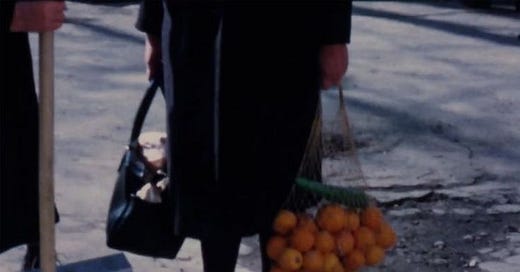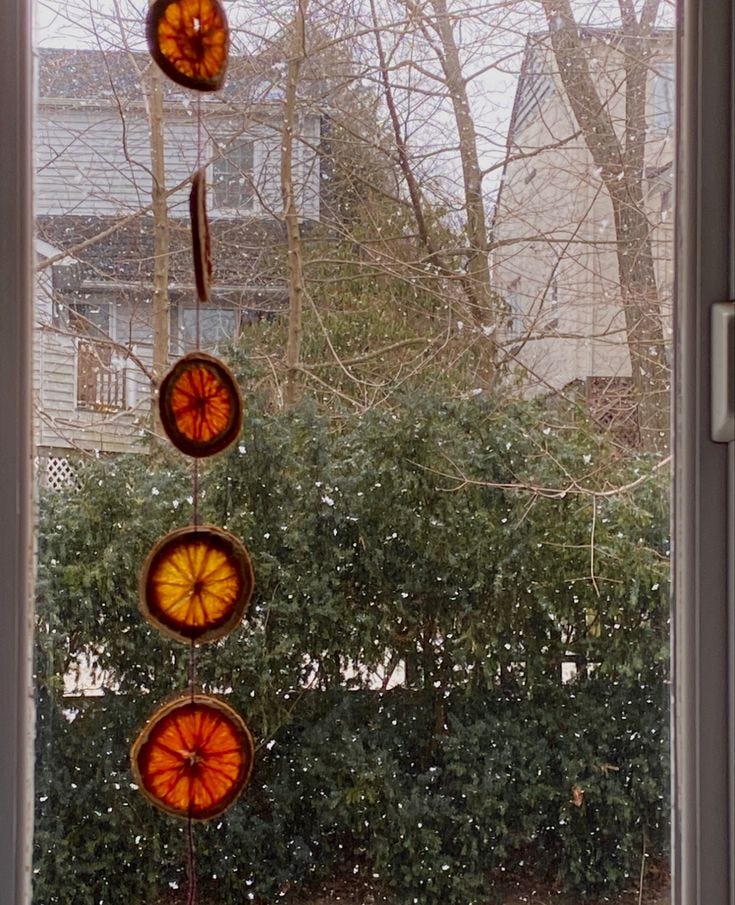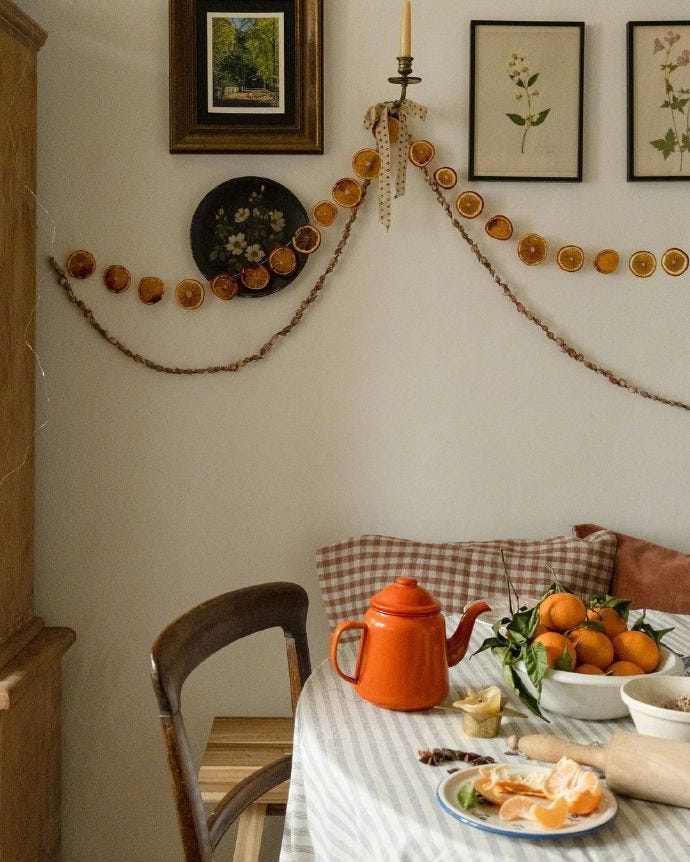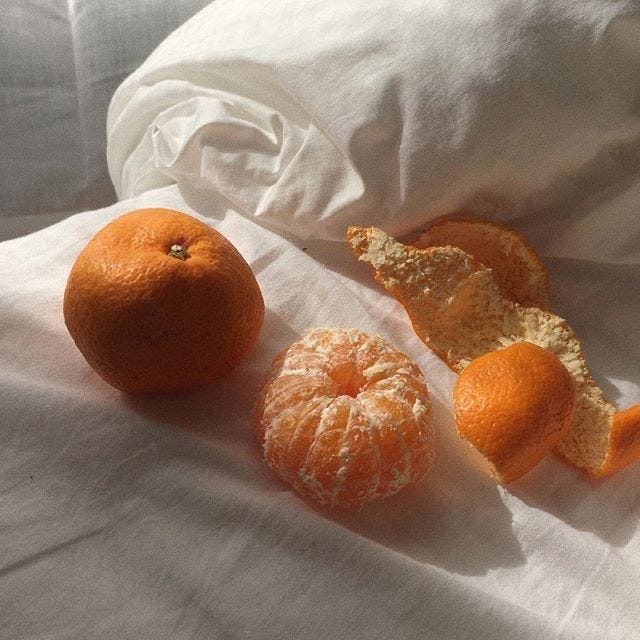hello.
my grandfather used to tell me stories about his christmases as a young boy. growing up in compton with a single mother of four kids meant a lifestyle of frugality, especially around the holidays. kids at his school would return from winter break talking about all the gifts they received. when asked about the gifts he got from santa, he replied, “a clementine— the most delicious clementine i’ve ever tasted.” he told me it was so good, he and his brothers and sisters decided to make orange juice with it so they could drink it with breakfast the following day.
every year when he tells me this story, i always ask him how the other kids responded. he replies humbly, “it didn’t matter what they thought. i got everything i wanted for christmas—my family, my health, my favorite dinner of cheesy walnut balls with bread pudding for dessert, and a clementine from my mother’s clementine tree.”
later in life, after he married my grandmother, they bought a house that sat on several acres of land. there, he fell in love with gardening, planting an abundance of orange, lemon, apple, and avocado trees. some years, he would experiment with stone fruit trees like apricots, plums, and peaches. when i was a little girl, he would take me into the orange groves and hoist me up onto his shoulders so i could pick the oranges from the very tops of the trees. we cooked together frequently, and i baked alongside my grandmother anytime i stayed at their house.
i was raised in a seventh-day adventist home, which meant food played a pivotal role in our family gatherings and daily lives. the seventh-day adventist religion abides by strict dietary regimes. many adventists follow vegetarian or plant-based diets, not just as a matter of health but as an expression of their spiritual beliefs. the seasons dictated what was available, and we embraced that rhythm. winter, in particular, brought a kind of reverence for hearty, grounding foods that nourished both the body and the soul.
and despite how our church cookbooks were filled with recipes that served plates of brown and beige foods—lentil loaves, nut patties, and casseroles thick with cream and breadcrumbs—the food was comforting and nourishing, and possibly even bewildering to people outside of our religion. the dishes reflected a practicality and a reverence for simplicity, deeply rooted in the seventh-day adventist ethos. to someone unfamiliar, these meals might have seemed strange or unappetizing, perhaps even unapproachable in their earnestness. but to us, they were a source of warmth and tradition, a culinary language spoken in potlucks, family dinners, and sabbath lunches. every dish told a story of resourcefulness, of creating abundance from simple, humble ingredients. in their unassuming way, these recipes offered something sacred—a reminder that food, even in its simplest forms, has the power to nourish not just the body, but also the spirit.
i remember wandering through the aisles of the loma linda markets with my grandparents on early friday afternoons, surrounded by shelves stacked high with worthington cans, fried-chic, big franks, and other quintessentially adventist staples. tucked inside the store was a small market counter that served the best veggie burgers and corn dogs, paired with a tangy, unforgettable yellow dipping sauce. there was also a corner for mexican food, where bean and cheese pupusas were served with a rich, comforting tomato sauce. the smells wafting through the market—savory, warm, and faintly sweet—wrapped around me like a familiar blanket. dishes like chocolate prune cake and walnut wheat sticks, strange and curious to those outside our faith, felt like pure comfort to me, embodying the flavors and memories of my childhood. these foods weren’t just sustenance—they were tradition, ritual, and the quiet language of home.
citrus season was synonymous with winter in our household. the arrival of cooler months meant the kitchen was filled with the bright tang of oranges, lemons, and grapefruits, their vibrant hues a contrast to the muted tones of winter skies. my grandmother would make her signature orange marmalade, spreading its bittersweet brightness over freshly baked biscuits. lemon bars became a staple at family gatherings, their tartness cutting through the richness of holiday meals. even the act of peeling a clementine became something ceremonial—a quiet moment of gratitude for the sweetness nature provides when the world outside feels cold and barren.
winter foods were about warmth and comfort, about sustaining ourselves through the darkest months. they were soups simmered for hours, breads baked with care, and desserts spiced with cinnamon and cloves, evoking a sense of nostalgia and tradition.
on weekends during the winter, my mom, grandmother, and i would gather in the kitchen to prepare for family get-togethers. the air inside was warm, often fogging the windows, creating a little cocoon from the chill outside. the kitchen smelled of rising bread dough, roasting vegetables, and the unmistakable aroma of citrus being zested for cakes or steeped into teas. the rhythm of our cooking mirrored the rhythm of the season—slow, deliberate, and deeply comforting. we’d roast butternut squash with sage, bake cornbread to pair with hearty soups, and assemble desserts that felt like edible celebrations of winter itself.
our family recipes were simple but brimming with care. my grandmother always insisted on making her orange marmalade in december, slicing the fruit paper-thin and simmering it with sugar and spices until it filled the house with an almost magical fragrance. my mother was the queen of making pies—apple, pecan, and her famous citrus tart, which she only ever made in winter. together, we folded, whisked, peeled, and tasted, creating not just food but memories woven into the fabric of our family.
what stands out most to me now isn’t just the meals we prepared, but the act of cooking together—the way it connected us.
this connection to food, especially during the winter months, became a cornerstone of my identity. my grandfather’s garden was a source of endless lessons, not just about growing and harvesting but about patience, care, and gratitude. i learned to see the seasons in the food we ate, to appreciate the abundance of summer and the quiet generosity of winter. even now, as an adult, i find myself drawn to seasonal cooking. winter, in particular, feels like a time to slow down, to savor the process of preparing meals, and to reflect on the year that’s passed.
as i’ve gotten older, i find myself returning to these memories each winter, peeling my own first clementine of the season. there’s something sacred in that small, quiet act—a reminder of the joy my grandfather found in simplicity, the abundance he created from so little, and the love that went into every meal he shared with us. the first clementine is more than a piece of fruit; it’s a ceremony, a memory, and a bridge between generations.
now, as i sit in my own kitchen, miles away from the groves where i once reached for the sunlit tops of trees, i think about how food continues to root me. it’s a connection to my past, a celebration of the present, and a promise to carry these traditions forward, one clementine at a time. food grounds us in ways few other things can. it reminds us of where we come from, of who we are, and of the moments and people that have shaped us. in the quiet act of peeling a clementine, i find not just sustenance but a kind of solace—a reminder that even in the stillness of winter, there is sweetness to be found.
reader, are you craving comfort, too?
let me share some books and cinema to consume:
books:
kitchen by banana yoshimoto – a tender, quietly profound story of grief, love, and the healing power of kitchens and shared meals. yoshimoto’s prose feels like a warm bowl of soup on a cold winter day.
tender at the bone by ruth reichl – a memoir that blends food, memory, and family with humor and poignant reflection, capturing how meals shape the contours of our lives.
the housekeeper and the professor by yoko ogawa - this tender novel about a brilliant mathematician with short-term memory loss and the single mother who becomes his caretaker is a quiet meditation on memory, connection, and the beauty of small moments.
a moveable feast by ernest hemingway – while not strictly winter-themed, hemingway’s recollections of paris are filled with cozy cafés, simple meals, and the reflective, wistful tone of a season of quiet introspection.
convenience store woman by sayaka murata – a story of identity, societal expectations, and the comforting rituals of daily life, including the small but meaningful acts of preparing and consuming food.
films:
ratatouille (2007) – a heartwarming celebration of cooking, connection, and finding beauty in the simple joys of food.
phantom thread (2017) – with its lush cinematography and precise attention to ritual, this film feels like a wintry meditation on intimacy, creativity, and control.
sweet bean (2015) – a tender story about a dorayaki shop owner and an elderly woman with a secret recipe, blending food, friendship, and healing.
tampopo (1985) – a quirky, philosophical love letter to food, filled with humor and reverence for the way meals can bring us together.
the shop around the corner (1940) – a timeless romantic comedy set in a snowy european town, with its charm, warmth, and sense of quiet magic making it a perfect winter watch.
little forest (2018) – a korean film about reconnecting with nature and oneself through seasonal cooking and simple living, brimming with warmth and quiet beauty.
the makanai: cooking for the maiko house (2023) – a serene and heartwarming series about the power of food to nourish and connect, set in the tradition-rich world of kyoto’s maiko culture.
okay, that’s all for today. happy winter solstice.
if you’re not ready to become a paid subscriber and you have the capacity to leave a tip, that would be so appreciated.
i love you.
bye.









I love this ode to food! This was so comforting to read, and I learned something new about your religious connection with food as well. Currently trying to find something festive to make myself.
ok adding cheesy walnut balls and chocolate prune cake to the list of food to eat before I pass